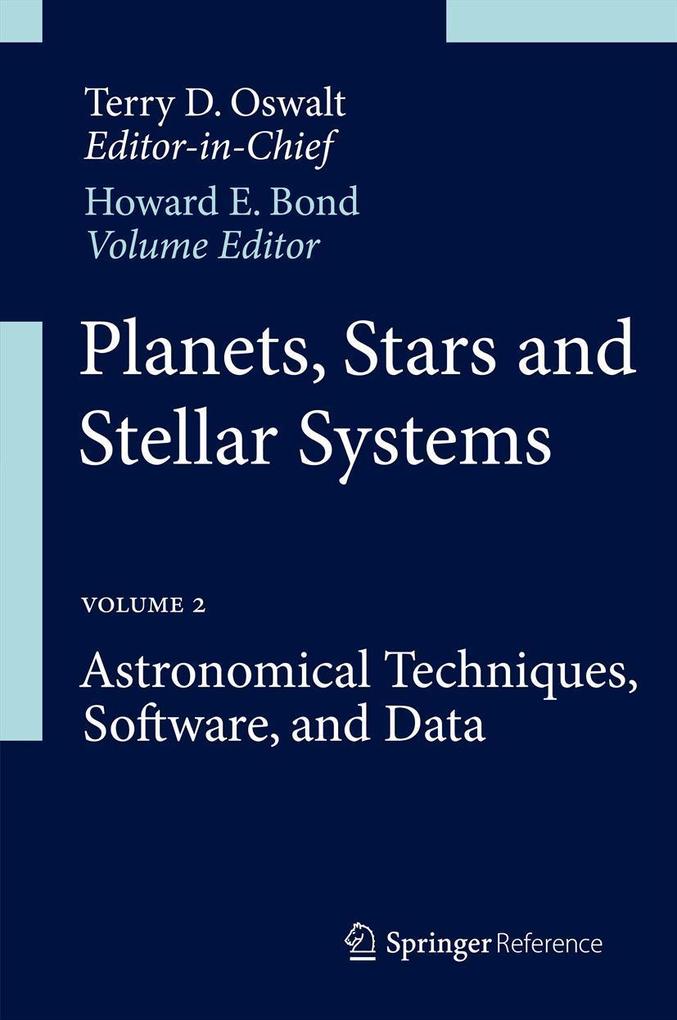
Zustellung: Fr, 04.07. - Di, 08.07.
Versand in 1-2 Wochen
VersandkostenfreiBestellen & in Filiale abholen:
This second in a six-volume compendium of modern astronomical research covers astronomical techniques, software, and data. Each chapter stands on its own and each volume can be used as a text or reference for advanced undergraduate or postgraduate courses.
This is volume 2 of Planets, Stars and Stellar Systems, a six-volume compendium of modern astronomical research covering subjects of key interest to the main fields of contemporary astronomy. This volume on Astronomical Techniques, Software, and Data edited by Howard E. Bond presents accessible review chapters on Astronomical Photometry, Astronomical Spectroscopy, Sky Surveys, Absolute Calibration of Spectrophotometric Standard Stars, Astronomical Polarimetry: polarized views of stars and planets, Infrared Astronomy Fundamentals, Techniques of Radio Astronomy, Radio and Optical Interferometry: Basic Observing Techniques and Data Analysis, Statistical Methods for Astronomy, Numerical Techniques in Astrophysics, Virtual Observatories, Data Mining, and Astroinformatics.
All chapters of the handbook were written by practicing professionals. They include sufficient background material and references to the current literature to allow readers to learn enough about a specialty within astronomy, astrophysics and cosmology to get started on their own practical research projects. In the spirit of the series Stars and Stellar Systems published by Chicago University Press in the 1960s and 1970s, each chapter of Planets, Stars and Stellar Systems can stand on its own as a fundamental review of its respective sub-discipline, and each volume can be used as a textbook or recommended reference work for advanced undergraduate or postgraduate courses. Advanced students and professional astronomers in their roles as both lecturers and researchers will welcome Planets, Stars and Stellar Systems as a comprehensive and pedagogical reference work on astronomy, astrophysics and cosmology.
All chapters of the handbook were written by practicing professionals. They include sufficient background material and references to the current literature to allow readers to learn enough about a specialty within astronomy, astrophysics and cosmology to get started on their own practical research projects. In the spirit of the series Stars and Stellar Systems published by Chicago University Press in the 1960s and 1970s, each chapter of Planets, Stars and Stellar Systems can stand on its own as a fundamental review of its respective sub-discipline, and each volume can be used as a textbook or recommended reference work for advanced undergraduate or postgraduate courses. Advanced students and professional astronomers in their roles as both lecturers and researchers will welcome Planets, Stars and Stellar Systems as a comprehensive and pedagogical reference work on astronomy, astrophysics and cosmology.
Inhaltsverzeichnis
1. Astronomical Photometry. 2. Astronomical Spectroscopy. 3. Infrared Astronomy Fundamentals. 4. Astronomical Polarimetry: Polarized Views of Stars and Planets. 5. Sky Surveys. 6. Techniques of Radio Astronomy 7. Radio and Optical Interferometry: Basic Observing Techniques and Data Analysis. 8. Absolute Calibration of Spectrophotometric Standard Stars. 9. Virtual Observatories, Data Mining, and Astroinformatics. 10. Statistical Methods for Astronomy. 11. Numerical Techniques in Astrophysics.
Mehr aus dieser Reihe
Produktdetails
Erscheinungsdatum
27. Februar 2013
Sprache
englisch
Auflage
2013
Seitenanzahl
524
Reihe
Planets, Stars and Stellar Systems
Herausgegeben von
Howard E. Bond, Terry D. Oswalt
Verlag/Hersteller
Produktart
gebunden
Abbildungen
XVI, 508 p. 38 illus. in color.
Gewicht
945 g
Größe (L/B/H)
241/160/33 mm
ISBN
9789400756175
Entdecken Sie mehr
Bewertungen
0 Bewertungen
Es wurden noch keine Bewertungen abgegeben. Schreiben Sie die erste Bewertung zu "Planets, Stars and Stellar Systems" und helfen Sie damit anderen bei der Kaufentscheidung.














